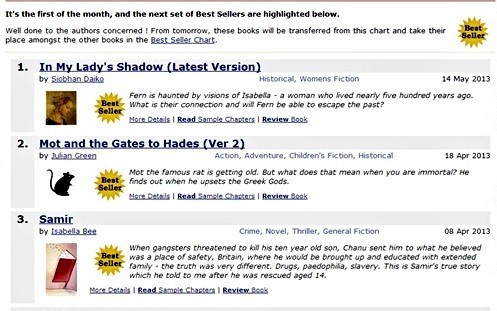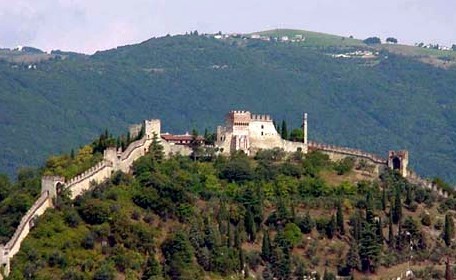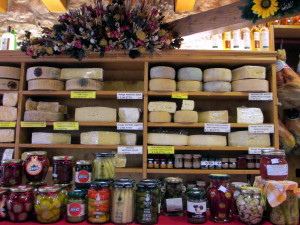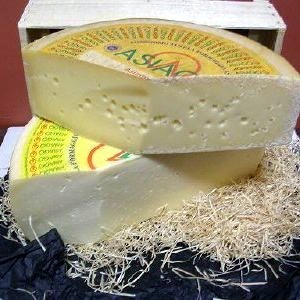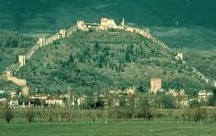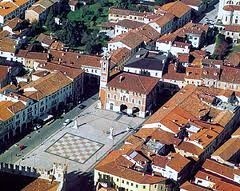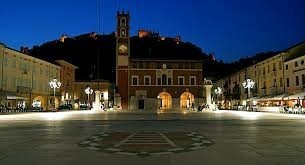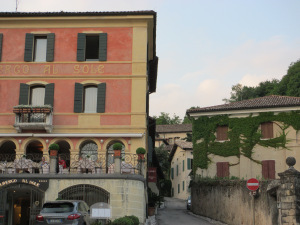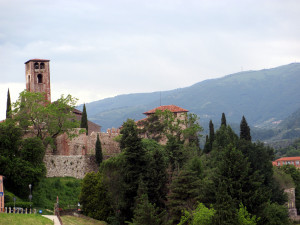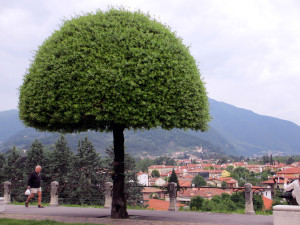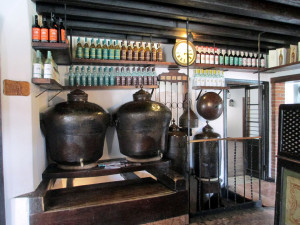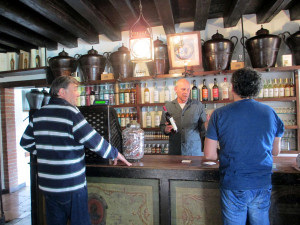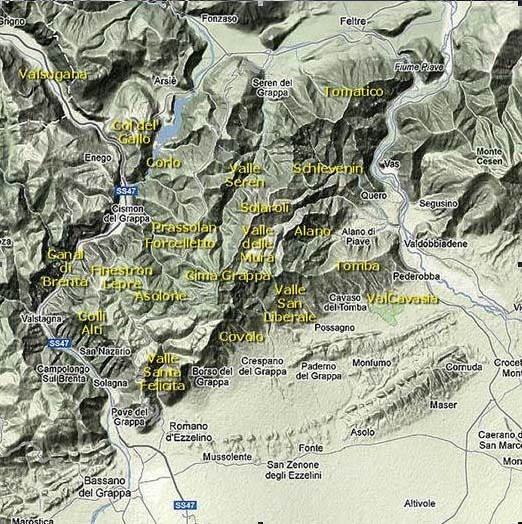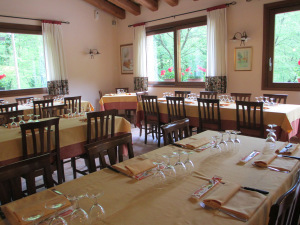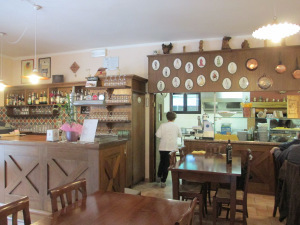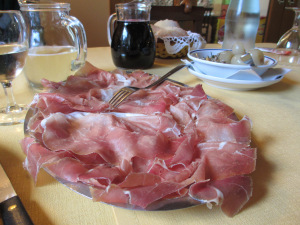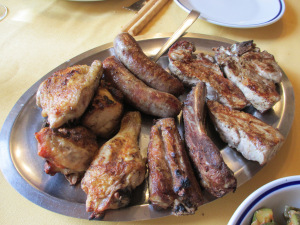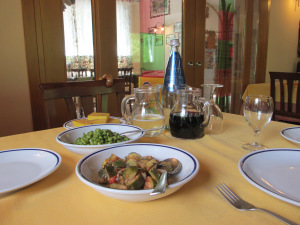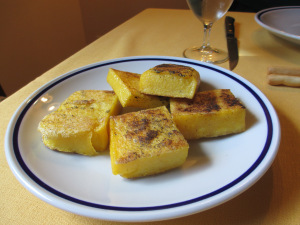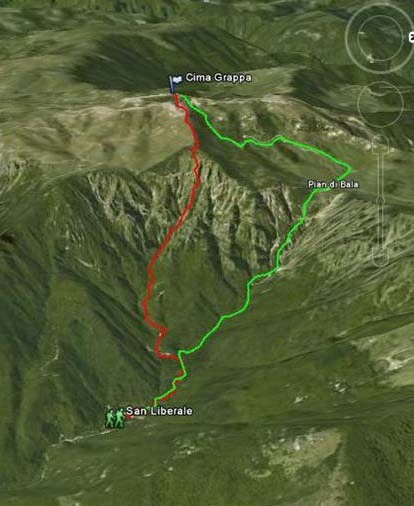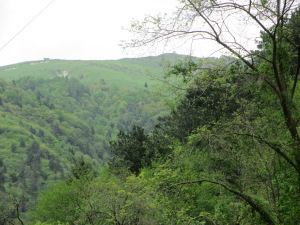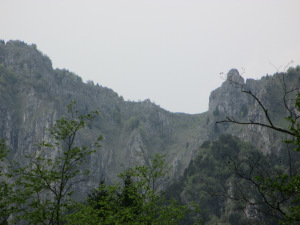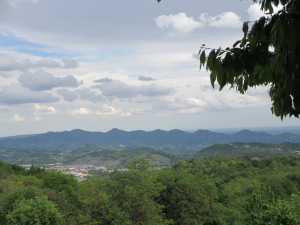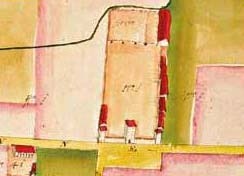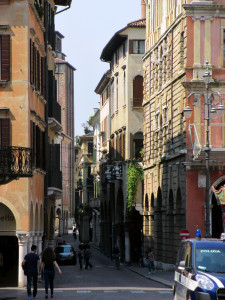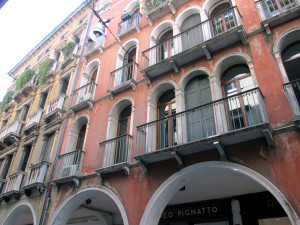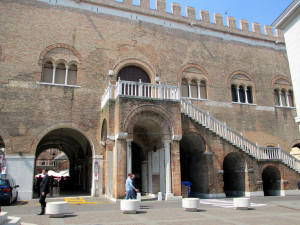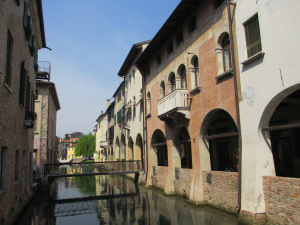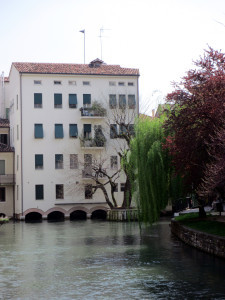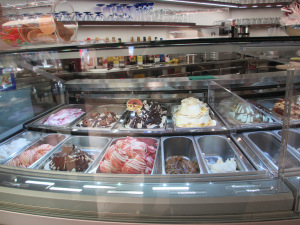Siobhan Daiko's Blog, page 18
August 14, 2013
Asolo – town of a hundred horizons
Asolo has been described as the town of a hundred horizons. From every angle there’s another spectacular view. This is how we see it from our place (with a zoom lens). If you look up the word “asolare” it’s defined as “the action of someone who, to shake off stress, goes out to breathe deeply in the open air.” How can anyone fail to “asolare” here among the olive orchards and vineyards?
 My next picture is taken looking towards the Borgo Santa Caterina district with Caterina Cornaro’s Castle to the right and the medieval fortress overlooking the town to the left, a close-up of the view from our house, except ours is partly obscured by the Monte dei Frati hill (Bottom right of above pic).
My next picture is taken looking towards the Borgo Santa Caterina district with Caterina Cornaro’s Castle to the right and the medieval fortress overlooking the town to the left, a close-up of the view from our house, except ours is partly obscured by the Monte dei Frati hill (Bottom right of above pic). And the other side of the hill leading up to Borgo Santa Caterina, the Forresto di Pagnano district, shows a different angle.
And the other side of the hill leading up to Borgo Santa Caterina, the Forresto di Pagnano district, shows a different angle.
 Below I have reproduced one of the most iconic views of the town. To the left are the castle grounds and, in the centre, the cathedral campanile points towards the Rocca fortress like a giant finger.
Below I have reproduced one of the most iconic views of the town. To the left are the castle grounds and, in the centre, the cathedral campanile points towards the Rocca fortress like a giant finger. What I love about this place, which I first visited when I was ten years old, is that it hasn’t changed (unlike the Hong Kong of my childhood). As Bernardi said in The Asolan Spirit, “the living rock and rosy humanity of the small town buildings transmits an idea of perpetuity, of permanence, insofar as can ever exist on Earth. Perhaps that is one of the secrets of Asolo.” I have set my work in progress, In My Lady’s Shadow, here. Who can live near this magical setting and not be inspired to write, paint, sing or dream about it?
What I love about this place, which I first visited when I was ten years old, is that it hasn’t changed (unlike the Hong Kong of my childhood). As Bernardi said in The Asolan Spirit, “the living rock and rosy humanity of the small town buildings transmits an idea of perpetuity, of permanence, insofar as can ever exist on Earth. Perhaps that is one of the secrets of Asolo.” I have set my work in progress, In My Lady’s Shadow, here. Who can live near this magical setting and not be inspired to write, paint, sing or dream about it?


August 5, 2013
Early chapters of In My Lady’s Shadow win a professional critique on YouWriteOn
Each month, a number of the highest rated authors with the best opening chapters in the YouWriteOn Top Ten Chart enter the Best Sellers Book Chart. The Top Five authors who enter the Best Sellers Book Chart from the Top Ten each month, receive a free critique from a literary professional. See YouWriteOn’s About Us page.
The opening chapters of my novel In My Lady’ Shadow entered the YouWriteOn Best Sellers chart on 2nd August and I should receive my professional critique in about 6 – 8 weeks’ time. You can read these chapters here.


July 12, 2013
Apricots and Cheese in Asiago
What to do when the weather is baking hot? Go up a mountain or to the beach, of course! Well, the other day we decided to opt for a day-trip to Asiago. Less crowded than the Adriatic and a bit nearer to where we live.
We took the road up from behind Marostica (see previous post)
to the small town, nestled on the plain at the summit. 
It was here that a battle was fought in May 1916, during World War I, after an unexpected counter-offensive was launched by the Austro-Hungarians. We’ve visited the War Memorial and museum on previous occasions. Ernest Hemingway also fought here. And, in a later engagement in 1918, Edward Brittain, brother of Vera Brittain, was killed and was buried in the Granezza British military cemetery on the plateau. In 1970 Vera’s ashes were scattered on his grave.
But we weren’t focusing on past tragedy this time. Asiago is famous for its cheese and so we headed for a shop to buy some.
Punnets of juicy apricots also caught our eye and we chose the one on the top left of this picture.
After a stroll around the town and some discussion, we decided to take a different route back down to the Sugana Valley
and counted more than twenty hairpin bends on the way.
Great views compensated for the somewhat scary drive and, safely home, we decided to try this recipe for Apricot Cake. Delicious!


June 26, 2013
Chess and Cherries in Marostica
The other day we took the mountain road from Bassano and stopped off for a delicious lunch at another of our favourite restaurants, La Rosina. 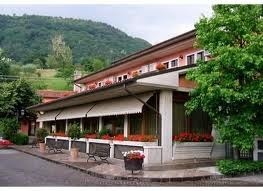
Then we drove down to Marostica for a stroll around this richly historic town. It’s only a half hour drive from Vicenza and ten minutes on the lower road from Bassano. The ancient wall encircles the fort at the top and reaches its arms down as if it were hugging the small city at the foot of the hill.
The piazza below is dominated by the lower castle where every other year, in September, they play a “live” game of chess. The next one will be in 2014.
The chess match is based on a story in which “Two noblemen, Renaldo D’Anganaro and Vieri da Vallanora, fell in love with the beautiful Lionora, daughter of the local lord, Taddeo Parisio. As was the custom at that time, they challenged each other to a duel to win the hand of Lionora. The Lord of Marostica, not wanting to make an enemy of either suitor or lose them in a duel, forbade the encounter. Instead he decreed that the two rivals would play a chess game, and the winner would have the hand of Lionora. The loser of the chess game would also join the family, through marrying her younger sister, Oldrada. During the play the game takes place on the square in front of the Lower Castle with supporters carrying the noble ensigns of Whites and Blacks, in the presence of the Lord, his noble daughter, the Lords of Angarano and Vallonara, the court and the entire town population. The Lord also decides the challenge would be honoured by an exhibition of armed men, foot-soldiers and knights, with fireworks and dances and music”.
I always used to feel sorry for Oldrada, who got the “loser” and hoped she secretly loved him best, then I was disappointed when I found out this romantic tale has nothing to do with factual history and the chess square in Marostica was built after the Second World War to enact a play written by the comedy writer Vucetich Mirko. Even so, the match has made Marostica famous and the re-enactment brings to life 15th Century Italy, the period in which I have set my current work in progress. I say to myself it might have been based on some truth and, if not, “non importa”.
Marostica is also celebrated for its cherries and we bought a bowl- full to take home with us. Life is so “dolce vita” here in Italy …


June 19, 2013
Blogging Award
I’ve added a NEW PAGE here called *BLOGGING AWARD* as it seems Becky from Becky’s Book Notes felt I was in need of some sweetening and has nominated me for the “Super Sweet Blogging Award”. Check out and follow my 13 nominations, all deserving of the award. Thank you so much, Becky, for nominating me. I hope you and my nominees are enjoying life. Here, the weather has turned very hot so I won’t be having an adventure this week. Still, there’s plenty of romance to keep me going as I write “In My Lady’s Shadow” and revise/polish “The Only One”.


June 13, 2013
Asolando
‘Asolando’. The word was coined by the English poet Robert Browning (see my post of 4th February), who named his last volume of poetry after the town of Asolo. I like to think I am “asolando” literally “doing Asolo” when I visit my favourite town and yesterday evening my darling Victor and I went for a stroll around the Piazza Garibaldi before indulging in some scrummy food and drink. In the car-park we took a picture of the Roman aqueduct, “La Bot”,
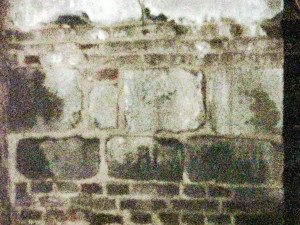 dug deep into the rock of the hillside, which still supplies the water feeding the fountain in the middle of the square.
dug deep into the rock of the hillside, which still supplies the water feeding the fountain in the middle of the square.  Gazing to the northeast, we could see the outline of the Fort (see my post of 16th February).
Gazing to the northeast, we could see the outline of the Fort (see my post of 16th February).
 We decided not to walk up the steep path behind, reserving our energy for another visit earlier in the day.
We decided not to walk up the steep path behind, reserving our energy for another visit earlier in the day.
Instead, we strolled down to the Palazzo della Ragione, with remains of ancient frescoes on the external walls of its loggia, where justice was administered when Asolo belonged to the Venetian Republic.
This building would have been familiar to the characters in my work in progress. We could see the marks from where some of the memorial tablets were removed after the French occupation under Napoleon. To the left of the loggia we looked towards the cathedral, whose present façade (1889) rests against the ancient Romanesque one.
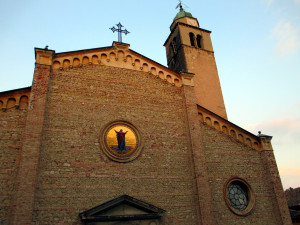 Inside is a baptismal font, a gift from Caterina Cornaro, the “Lady” in my novel, to the people of Asolo. From the terrace in front of the church there’s a clear view across the plain towards Padova and the distant Euganean Hills.
Inside is a baptismal font, a gift from Caterina Cornaro, the “Lady” in my novel, to the people of Asolo. From the terrace in front of the church there’s a clear view across the plain towards Padova and the distant Euganean Hills.
Thirsty and hungry, we headed for the Birreria Epoca and plonked ourselves down on the outside terrace.
We ordered a “birra bionda” and a “birra bianca” 
with “olive ascolane” 
then shared an insalatona and “spaghetti all’aglio, olio e peperoncino”
and “spaghetti all’aglio, olio e peperoncino”
and a gelato Why not? Perchè no?
Why not? Perchè no?
May 30, 2013
A pizza, a kiss, a grappa and an ice-cream in Bassano
Last week we visited one of our favourite towns, Bassano del Grappa, which is situated in the province of Vicenza and only a twenty minute drive from where we live. The castle dates from 1150 and was once in the hands of the notorious Ezzelino family
We arrived at the start of the lunch break and found a park in the Viale dei Martiri. During the second world war, the mountains behind Bassano were a centre for partisan fighters. They organized raids on the main supply route from Germany to the troops stationed in Italy. In 1944 the Germans took revenge by marching up the mountain behind women, children and elderly local inhabitants. Any partisans discovered or civilians suspected of assisting partisans were killed. There were public hangings and shootings with families forced to watch. On 26th September they hanged 31 young men from the trees in this road, which is why it’s now called “Martyrs’ Way”. Every tree is shaped like a soldier’s helmet and bears the name of one of the victims and his age. So tragic!
We wandered down to the square where the Loggia dates from the early 15th Century; it would have been familiar to the characters I’m writing about in my work in progress. 
We had lunch at the Pizzeria Marechiaro
Then we set off back across the square and down towards the river, taking a photo of the Lion of St Mark, a reminder that Bassano was under the dominion of the Republic of Venice from 1400-1797.
Bassano is famous for its handmade ceramics and there are many shops selling items in majolica and porcelain. 
We headed for the Ponte degli Alpini which spans the River Brenta
The bridge is first mentioned in the 11th century and has been rebuilt several times due to flooding or destruction during wars. It is still the original design by Palladio from 1569. The bridge is built of wood, making it more resilient to the fast flowing river. There’s a famous mountain song about two lovers who hold hands and give each other a kiss on the bridge, which is also beloved by the Alpini Regiment. Sul ponte di Bassano; là ci darem la mano; là ci darem la mano; ed un bacin d’amor. After a brief chorus and a kiss (a group of locals fell about with laughter), we took some pictures of the beautifully coloured palazzi and gardens on the river banks then warmed our cockles in the Grappa Nardini Shop.
Some think Basano del Grappa takes its name from the liqueur grappa, but it’s actually named after the mountain range behind the town. The name of the liqueur stems from “grappolo”, meaning a cluster of grapes. Grappa has been produced in Bassano since 1779 when Bortolo Nardini bought a Grapperia on the Brenta River bank. The liqueur is made from the by-products of wine making – the seeds, stems and skins. The company is still run by members of the Nardini family. It’s an acquired taste – a bit like firewater – and high grade alcohol content means you have to take care, but a small amount works wonders for the digestion.
On our way back to the car we saw this sign: 
“Whoever eats our ice-cream will become more good-looking” How could we resist?


May 19, 2013
Val San Liberale
Yesterday, we had lunch at one of our favourite places, the Ristorante Val San Liberale.
Situated in the Comune of Paderno del Grappa in the province of Treviso, Val San Liberale is reached by turning off the road from Pederobba to Bassano del Grappa at Fietta then following the Lastego valley as it gently rises to six hundred metres.
The food at Val San Liberale is simple but delicious and we always get the warmest of welcomes from the owners, Mariangela and Giampietro. I’ve been visiting this osteria since I was a teenager – when the road up was a rough track, the facilities basic, but the food always fantastic. Nowadays, after extensive renovations, the restaurant is well-furbished yet hasn’t lost any of its charm.
The menu offers enough choice for most tastes and is reasonably priced.
We usually have the antipasto of sliced prosciuto crudo with sott’aceti
followed by the mixed grill, freshly prepared by Giampietro, with peas from Borso and zucchini.
Ristorante Val San Liberale specialises in snails with polenta cooked in various ways, but we chose the toasted polenta without the lumache.
After lunch we went for a short walk, taking pictures of Monte Grappa which towers over the valley at one thousand seven hundred and seventy-five metres. We keep promising ourselves that one day, when we’re fit enough, we’ll attempt the walk up to the top.
Driving back down, we stopped to take a photo of the view of the distant colli asolani and the back of our place, which is in the centre of the middle range of hills.


May 10, 2013
Caterina Cornaro’s “Barco”
What I love about the setting of my current WIP, “In My Lady’s Shadow”, is that I can visit my locations and dream about what they would have been like half a millennium ago. IMLS is partly set in Caterina Cornaro’s country estate, which was said, at the start of the Sixteenth Century, to be a place “worthy of a King of France”.
There were originally three enclosed spaces within an area of about 112 acres. The outer space was reserved for hunting and was filled with wildlife.
A model in the Giorgione Museum, Castelfranco, shows what the living quarters and gardens would have been like. All that remains today is part of the east wing.
Here is a painting of what was left of the estate in the 18th Century.
The whole complex, a cross between a castle and a Venetian villa, was a palace of relaxation and delights where Caterina Cornaro welcomed artists, writers, musicians and poets to her court. She considered the castle in Asolo too cramped and crude for a grand lady like herself and was lucky enough to have the money to build her “Barco” near the village of Altivole.
Partly destroyed by a fire during the sack of Asolo by the League of Cambrai in 1509, the Barco fell into neglect over the centuries. It was owned, for a time, by the Province of Treviso and the exterior was open to the public. Now the property of Benetton, when Victor and I went to visit the ruins a month ago, we could only stand and stare through the gate, imagining the hunts, parties, jousts and celebrations that took place here more than five hundred years ago.


April 19, 2013
Treviso or “Little Venice”
I used to think it such a shame that “Little Venice” is overlooked by the tourists who arrive on their RyanAir flights, and hop on a bus direct to the larger city of canals. The other day we decided to visit Venice’s “poor relation” and the capital of the province where we live. We arrived at lunchtime, a good time as parking is easier, and immediately found a space in the Piazza del Duomo.
Having already planned our route we set off on foot down the Via Calmaggiore.
This charming porticoed street leads to the Piazza dei Signori and was the main road in Roman times.
We took a pic of the Palazzo dei Trecento, which was built in the early thirteenth century, but on Wednesday echoed to the sound of university graduates celebrating their “laureate” with crowns of laurels, drinking in the numerous wine bars, and singing a dirty song “Dottore .. Dottore … Dottore del buso del c***”. I wonder how many of them will find work in these difficult times?
Giving them a wide berth, we headed for the Buranelli Canal to take some photos.
The River Sile and its tributary the Botteniga meet in Treviso and the water flows through several picturesque waterways that give the town its Venetian look. The warmth of the first sunny day in weeks on our arms, we soaked up the atmosphere and decided to come back here more often.
Back in the Piazza dei Signori we stopped for an icecream before returning to our car. A good thing Treviso isn’t too touristy, we thought with hindsight. It’s a gem we can keep to ourselves. Che bella città!



